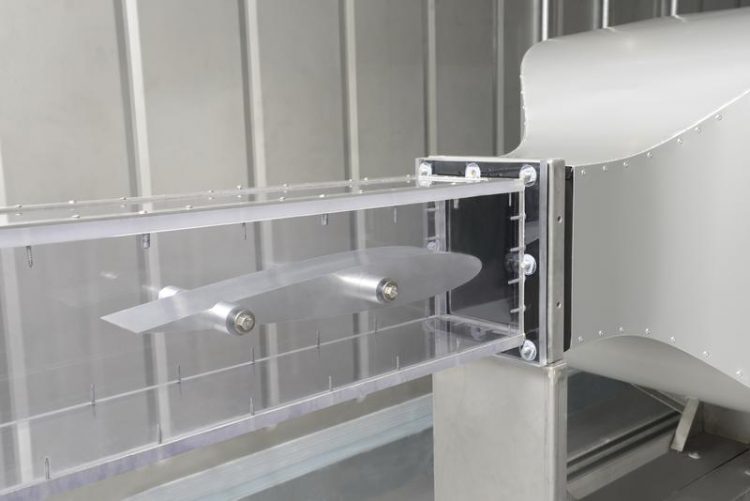New icing wind tunnel at Fraunhofer IFAM allows anti-icing tests under realistic conditions

Test zone with integrated wing section.
The Paint/Lacquer Technology Department at the Fraunhofer Institute for Manufacturing Technology and Advanced Materials IFAM has thus reached a further milestone for testing anti-icing coatings and innovative deicing technologies.
Fraunhofer IFAM researchers and their project partners from industry and R&D organizations will now be able to test anti-icing systems under realistic conditions at temperatures down to minus 30 degrees Celsius and at wind speeds of up to 350 kilometers per hour.
Preventing ice forming on surfaces is a major challenge. For aircraft, ships, rail vehicles, cars, air-conditioning systems, refrigeration units, and wind turbines – ice formation often endangers safety and also incurs high costs.
Intensive R&D is underway to develop ever more effective technologies for preventing the formation and adhesive of ice on technical surfaces. Fraunhofer IFAM is investigating a variety of solution-oriented approaches and for minimizing ice formation.
These include, for example, heatable coatings and their integration into a total coating concept. The heatable coatings are suitable for all uses and can be applied using conventional spraying methods, meaning that even components with very complex geometry can be rapidly and efficiently coated.
Highly promising results have also been obtained for hydrophobic, namely water-repelling, coatings that make ice adhesion more difficult.
Nanostructured surfaces and the direct integration of freezing point depressors into the coatings themselves are other anti-icing strategies that are being pursued.
All these anti-icing concepts are undergoing thorough testing. The icing wind tunnel is equipped with special control and monitoring equipment: To get defined ice formation the water injection and air humidity can be precisely controlled.
An infrared camera simultaneously records the icing process and the heat distribution on the surfaces. The new test laboratory with icing wind tunnel will facilitate ongoing and future R&D projects and will be used for fundamental research work, ice adhesion tests, and the investigation of surface icing by snow, rain, and supercooled water droplets.
Media Contact
All latest news from the category: Materials Sciences
Materials management deals with the research, development, manufacturing and processing of raw and industrial materials. Key aspects here are biological and medical issues, which play an increasingly important role in this field.
innovations-report offers in-depth articles related to the development and application of materials and the structure and properties of new materials.
Newest articles

Machine learning algorithm reveals long-theorized glass phase in crystal
Scientists have found evidence of an elusive, glassy phase of matter that emerges when a crystal’s perfect internal pattern is disrupted. X-ray technology and machine learning converge to shed light…

Mapping plant functional diversity from space
HKU ecologists revolutionize ecosystem monitoring with novel field-satellite integration. An international team of researchers, led by Professor Jin WU from the School of Biological Sciences at The University of Hong…

Inverters with constant full load capability
…enable an increase in the performance of electric drives. Overheating components significantly limit the performance of drivetrains in electric vehicles. Inverters in particular are subject to a high thermal load,…





















